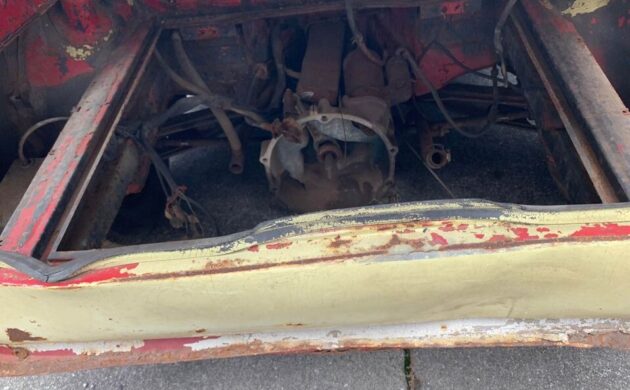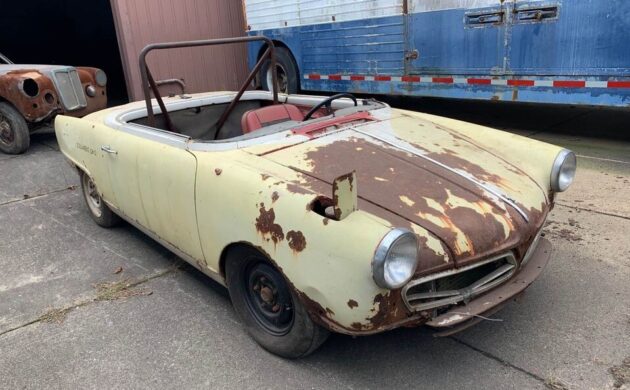While we generally find old cars interesting, there are some that stand out for packing in far more novel features than anyone may have expected. The NSU Spider is a terrific example of this, as it was a groundbreaking car when you take stock of the engineering features it offered. The most significant of which was a water-cooled single rotor engine, making it the first production car from the Western world to be powered a Wankel engine. Find the former track rat here on Facebook Marketplace for $5,500.
Thanks to Barn Finds reader T.J. for the find. Not only did it break new ground with the rotary engine, but it was also designed by Bertone and came with front disc brakes, standard. The styling is by no means unattractive, especially in track car form. The production model wasn’t particularly sporting-looking, but with the windscreen removed, a roll bar, and lowered suspension (or whatever you do to bring one of these closer to the ground.) The decal stating “Columbus, Ohio” on the side, so perhaps one of you remembers this roadster on the track back in the day.
The seller does confirm this limited-production roadster raced in the sixties. I’d love to meet the original racer who looked at this oddball and thought it’d make a terrific race car. Despite the empty engine bay, the NSU will come with a two-rotor NSU Wankel short block engine. No word on why the engine got yanked in the first place, but knowing what we know about the love and attention rotary mills need, it’s not an unreasonable conclusion that it may have needed a rebuild.
This is one of those cars that offers a tremendous about of value in the smile-per-dollar category. No matter how you use it, you’ll find fans and admirers who want to know more about it, or give you props for keeping such an epic piece of racing history on the road. I’d leave the roughshod paint and perhaps upgrade the wheels to something period-correct but not refinished; some dusty Libre wheels would look amazing on here. Build up that little Wankel as much as you can and go racing.






Looks like an amphibicar from the back
Love the gas filler door on the front fender
I have never seen one of these and have zero experience with a rotary but it is cool for sure
It does look something like an Amphicar at the back with early ’60s Sunbeam Alpine tail fins and tail lights.
The car’s overall air seems to say it spent its past on an amusement park dodge ’em track.
Pretty cool little oddity. But I wonder about that 2 rotor Wankle, was it from an RO-80? These has a single rotor engine. And a replacement for that might be as hard to find as the trim for this would be. And I doubt there would be space for the large motor, but I could easily be wrong about that.
Cool cars in the background, is that an Arnolt MG behind it? And a LaDawri in front of it? And what is that Excalibur truck?
Barn Finder’s reader TJ has found a Myron Vernis (Akron Ohio) NSU Wankel Spider offered for sale. The NSU wankel spider was the hot factory built spider with a two rotor wankel engine. The factory’s later RO-80 benefited from NSU’s production experience of the wankel spider.
Myron Vernis has one of the most amazing eclectic collection of automobiles in the world. Must see – his YouTube presentation of his 1953 Paxton Phoenix. Wonderful gentleman with encylopedic knowledge of unique automobiles.
Search for ‘NSU wankel spider’ to find all the specs, photos, clubs, a virtual trip round the world.
In the mid 1980s I sold 2 complete but not running red NSU Wankle Spyders, both had come out of the former NSU dealer in Washington DC; Allied Light Cars. My partner and I bought all of Allied’s cars, spare parts, and showroom items, and the 2 Wankel Spyders were part of that hoard. One of them had a rare black factory hardtop, and the former owner of Allied claimed it had been the one used in the Road & Track cover story when new.
As this car is not that far from Myron’s place, I’m wondering if it might have come from him. These cars are quite rare in the USA, and it was also red when new.
Spare parts for these cars are available in Europe, except for the specific parts for the Spyder roadster. The other parts are identical to the NSU Prinz Sports Coupe. At the time I sold the 2 cars, pieces like the taillights and the Wankel emblem on the decklid were impossible to find, but I hear they’ve been reproduced in Europe. ANYTHING pertaining to the engine will probably be expensive when [and if] found.
First reply may have exceeded BF word limit. Search NSU Wankel Spider.
The original was the NSU Sport Prinz, a real beauty in its day, one of my favorite micro cars for sure. HAving an Italian body, the rust problems however were formidable, same with the Glas 1700GT or the BMW 1600GT.. The original Sport Prinz was powered by an air cooled 500cc twin 4-stroke which was merely 2 NSU Super Max motorcycle engines joined at the hip – great little car, albeit the price was a bit steep.
From wiki:
In 1966, Al Auger of Richmond, California, became the first person to race a Wankel-powered production car in an officially sanctioned race. After only installing a mandatory roll-bar and racing tires on an NSU Spider, Auger raced in 1966 and 1967 in Sports Car Club of America sanctioned road races throughout California finishing second overall in the championship both years in Class H Modified. Because SCCA had no technical information about the Wankel engine it was placed in H Modified racing against lighter, more powerful, 850 cc highly modified pure race cars.
Same car???
The Excalibur trailer must have belonged to Brooks Stevens, who designed and built Excalibur cars in Wisconsin. Interesting that the NSU seller’s name is Steven Brooks. Years ago Brooks and his unforgettable car-wrangler Alice came on the Colorado Grand in a big post-war Alfa coupe. Just getting there was a challenge; their tow vehicle couldn’t pull the trailer and car up to the 10,000-ft Eisenhower tunnel on I-70, so they had to unload it. They finally made it but had at least three flat tires on the first day of the tour because the wire-wheel spokes rubbed on the inner tubes. Alice could swear like a sailor!
Frank,
I’ve seen that situation happen several times. Too many tire shops today have no clue why that inner flap of rubber MUST be install around the recessed area of the rim.
The flap protect the inner tube from the movement of the spoke ends as the wheels turn. This is also of concern for older wheels where the outer rim is attached to the inner part of the wheel [the section that has the bolt holes, etc.] with rivets, not welded together.
It doesn’t take much movement to quickly wear thru an inner tube because that movement happens with each rotation of the wheel. The rubber flap isn’t under air pressure, and as it’s a lot thicker, it rarely needs replacement.
From everything I have read about the Wankel it was a fantastic concept put into production before the teething troubles had been worked out. It matured into a sound power plant, but in its early stages it found it way into several cars and played a major role in their bankruptcies or restructuring.
If I had this car I would probably swap the original Wankel for a definitive Mazda Wankel.
It would be far more reliable and would deliver what avrotary promises in terms of smoothness and high revving power.
Yes, that would be an option, but ultimately fewer and fewer mechanics have the knowledge or experience to work on Wankel rotaries, even Mazdas. I owned a Mazda-powered car (a Maxton) and had difficulty finding a good mechanic who could make it run really right. That was one reason I sold it, as the situation is unlikely to improve.
Turbo four cylinder.
I love this one for sure. I wonder if it comes with a windshield and maybe top bows?